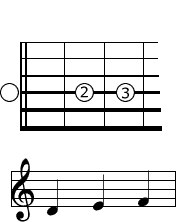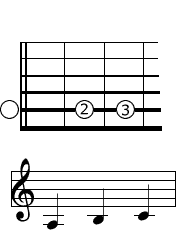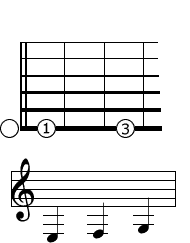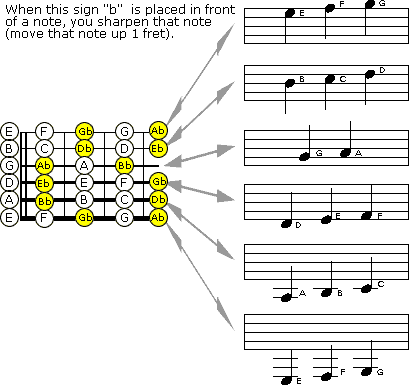Learning the strings
Introduction
What exactly is the best way to get started with the guitar.. or any instrument for that matter? At first, staring at a guitar seems like a cruel matrix of with strings tuned to seemingly arbitrary pitches. Even skimming the iceberg's tip of content available online, how is one supposed to get past learning the first few frets of the guitar (if one even makes it that far)? Isn't it strange that usually only the first few frets are taught, yet that's only 3% of the instrument? Will the same grueling effort have to be placed into learning all the rest of the instrument? And how do those people at the guitar store seem to play chords and move their fingers so fluidly, yet I can hardly pluck the proper string and fret the note? Is it only me who's facing these hurdles; am I the one person who's cosmically doomed from doing this, and yet here I am having spent my paycheques to get started?
In truth, it's a plethora of questions faced when starting out. And to be honest, while many start down the path of the 'method book #1' and 'newspaper classifieds teacher', others have famously started out with a dusty attic guitar and ham radio, while others have gone from 0-to-100 just learning actual songs from day-1. An overused analogy here is treating it like a board game; if there's one thing that won't help one learn Risk/Monopoly/Catan/Scrabble, it would be simply studying the game rules/instructions for hours on end. While playing that 'first turn' of a board game you don't know is secretly like reaching the top of a roller-coaster drop, with a nausea as the other players at the table watch you sweat, rolling the die and deciding what exactly to do, by the 'second turn' or 'third turn', the sting dies off, and the feelings turn from fear to curiosity. Imagine this first week with the guitar is like the 'first turn'; the feeling of nausea is natural. Play something, anything, rather than just reading the manuals/instructions, making it to the second week or 'second turn' -- that's all!
What's the best way to learn guitar?
If one had a crystal ball to determine if there's a "perfect"/universal way to pick-up the guitar, from scratch, would there be one, singular way? Unfortunately, no such crystal ball seems to exist; all one has to work with is basic logic.
2 confounding factors
Firstly, the guitar is, primitively speaking, the 'bow part' of a bow and arrow.. yes, really! It's theorized that hunter gatherers, after returning from mammoth hunts (or whatever their culinary preferences may have been), flipped their bows upside-down and 'twung' them, until dusk. Then, the engineer-creatives among the tribes steadily re-tailored their hunting bows to specialize as sonic tools, adding a resonating container with a hole cut into it to project the sound, dense materials at the start/endpoints of the strings to help the strings vibrate, metal bars/'frets' to alter the string pitches, winding tuners to set the default/'open' string pitches, and additional 'bow hairs'/strings to offer more 'twanging' options. In fact, it's only been for 100 of the past 20,000+ years of stringed instruments that metal strings have been commonplace. Before that, and still today, strings from the gut lining of animals was the material of choice; perhaps making use of the fruit of their hunting efforts. Thus, the 'guitar' is simply one recent 'child' of an ever-evolving ancestry of stringed instruments; why would there be one single, 'static', enshrined way to perfectly play it, especially since it's so new?
Then, tack on the fact that all humans, while sharing many over-arching learning styles, each have vastly different dispositions for learning. Combine those 2 fluid factors and there's logically no perfect way to pick-up the guitar. Instead, the old adage comes in handy of, "all ways, always". As mentioned before, the author here has witnessed players thrive just by jumping straight into learning multi-note/fingerstyle blues songs, but also by going the more 'standard'/'method-book-style' route of going string-by-string with mini-song-studies. An easier question to answer is, 'what are ways that will terminate/negate one's ability to progress at all on the guitar,' and that would likely be by not actually picking it up and playing the guitar. So, trying to practice what's preached here, why not get started with something, anything, right away!
How this guide works
In the spirit of just going ahead with it, this guide will go through the 6-strings of the guitar, from the thinnest to the thickest. While there are technically an infinite number of default/'open' string pitch combinations for the 6-strings, so-called "standard tuning" will be used; as the name suggests, it's a standardized sequence of pitches for each string, which has spontaneously/naturally developed over the 300+ year history of this stringed instrument.
Getting in tune
Why is the sequence of notes for standard tuning EADGBE (from thickest-to-thinnest)? The best guess is that it happens to be a sequence that physically allows for the human hand to conveniently fret a variety of chords. It may very well evolve into a yet more convenient sequence another 300 years from now, but for now it will do! To begin, twist the tuners on the guitar so that the 'open' (unfretted) pitches match these tones.
Those tuners mechanically alter the tension of the metal or nylon strings of the instrument; if the string is tighter, the pitch goes higher, and if the string is looser, the pitch goes lower; nothing more sophisticated than an elastic band wrapped around an empty tissue box! Now that the strings of your instrument have been standardized into the guitar's anointed "standard tuning", it's ready to be played.
1st string: the high-E string
The idea for now, since it's still early on, is focusing on 'bite-sized chunks'. At this stage, one might have so many questions about the guitar that it's instead forming balls of confusion, but just quell that feeling for the time being. This thinnest string of the guitar has a couple names when the guitar's tuned to standard tuning. These primarily include: (i) the high-E string, since it's tuned to the E-pitch, and (ii) the 1st-string. These names will be used interchangeably. Here are 3-notes on the high-E string to get started.. they include: (a) the open-E note, (b) the F-note on the 1st-fret, and (c) the G-note on the 3rd-fret. You might wonder, "what about the 2nd-fret?", but try not to worry about that for now! It'll actually be a while before speaking about that 'in-between' type of fret.

The style of this guide will follow this type of route; first, showing the notes of the string (in this case the high-E string), and, second, showing exercises/songs to put those notes into action. For this 1st-string, it's only this exercise to be test-driven, but there will be songs coming up as other strings are added!
i) 1st-string: exercise #1
To be noted here, two styles of notation are shown.. (i) the traditional music notation style on top, and (ii) the guitar tablature style below. It's quite extra to delve into a discussion comparing these 2 styles, but for a brief comparison...
But first, a tangent on musical notation vs tablature...
Traditional musical notation beats tablature because, visually, one can "see" the ups/downs of pitch because higher pitches are literally higher up on the lines/'staff'. Also, rhythms such as the length of notes or rests are visually represented, which allows players who have never seen/heard a piece of music play it as-written on-the-fly for the first time. On the other hand, guitar tablature doesn't immediately show you pitches/rhythms; instead, your brain has to first process the numbers to calculate whether one number is higher-up than another to anticipate pitch differences. Also, it doesn't show you rhythms as visually, so oftentimes a playalong-audio is needed to know how the song goes. It's a spree of pros-and-cons like anything.
While traditional notation has those boons, it's also a more abstracted language/syntax that one has to separately learn, while guitar tablature is "lower-level", relating exactly to the physical frets of the guitar. Another difference is that musical notation "consolidates" all pitches into one, whereas guitar tablature can represent the same pitch but on different strings (ie. the open-E string OR the 5th-fret of the 2nd-string, which have the same pitch.. this would be represented/consolidated instead as a single-point on the traditional music notation staff.. so tablature locks one into a particular position to play something whereas musical notation permits more leeway.)
Ultimately, usually guitar players opt for tablature due to its immense convenience. Though traditional music notation in-the-end leads to arguably better long-term outcomes, such as opening one to other genres of music (flamenco, classical) and incidentally helping with concepts such as memorizing the entire fretboard. In any case, here's the exercise for the first-string!
Next, it's time to add the 2nd-string into-the-mix. Keep in mind, by keeping oneself to the first 3-frets of the guitar, this is called "open position", because it's the hand position nearest to the default/'open', unfretted pitches of the strings. The other positions are called "1st position", "2nd position", and so on, which won't be talked about for this particular guide.
The same process for the 2nd-string
As mentioned before, it's standard to call each guitar string by 2-notes (at least when it's tuned to standard tuning): (a) the 2nd-string, since it's the 2nd-string from the "top", or (b) the B-string, since it's default/open pitch is the B-note. Similarly for the B-string, a few open-position notes will be talked about and then applied: (i) the open-B note, (ii) the C-note on the 1st-fret, and (iii) the D-note on the 3rd-fret.

As before, to help internalize these notes, just playing anything, doodling even, with them can help make the initial connections in the brain. Both the musical notation and tablature are shown, but it's slightly recommended to use the musical notation (at least for now) when playing pieces here. Since there's the visual aspect of the musical notation, it can help one play these exercises faster/sooner, which can lead to slightly faster learning.
2.1: Exercise #1
The guitarist Dan Wilson mentions that being musical when learning anything, whether as a beginner, or even at his level, is his preferred way to embed things into his brain or the brain of his guitar students. In that vein, these are a few songs to start feeling more musical about the, so-far, top-2 strings of the guitar. Again, relying more upon the standard musical notation is probably preferable for arguably quicker learning, but the tablature is always available also.
2.2: Song of Joy
2.3 Mary Had a Little Lamb
2.4 When the Saints (Go Marching In)
Onto the 3rd-string..
This 3rd-string is also called the G-string in standard tuning, since it's tuned to the G-note. Altogether, the top-3 strings are sometimes referred to as the "treble-side" strings (as opposed to the "bass-side" strings), with 'treble' referring to their relatively higher open-string pitches. For example, the treble-side strings often occupy the 'cherry-on-top' melody notes for chords or chordal guitar arrangements; this is likely since the human-ear tends to hear the top-most note first, using the lower frequency notes as supportive context for that top-most note. Of course, like any 'rules', they're meant to be defied and disproven, though that's simply to say that the G-string still often takes on that role.
For the notes with which to get acquainted, there are only 2-notes for now on the G-string: (i) the open-G note, and (ii) the A-note on the 2nd-fret.

Just as a recap of the treble-side strings so far, namely the (i) high-E string, (ii) B-string, and now the (iii) G-string, this is a map of the notes, alongside how they're abstracted into the syntax/visuals of traditional music notation.

Speaking of the sometimes cruel & confusion-causing matrix of frets and strings of the guitar, these grid-like patterns of note groupings, as they layout on the fretboard, are essential to how one can visualize where notes are.. on any stringed-instrument's fingerboard for that matter! While the business of memorizing such "boxes" and "cells" are a whole other discussion.. namely, relying solely upon such patterns to understand the fretboard, versus using them as one-of-many solutions.. they're undoubtedly useful. For example, one can actually shift/transpose the entire note-grid above by 1-fret, 2-frets, 4-frets, etc all the way up the fretboard (though keep in mind... all frets must transpose by the same amount), showing how there are some crackable methods-to-the-madness of the fretboard.
Anyhow, returning to this more grounded pathway, the digestion of the 3rd-string will follow the same routine as the other strings.. first, an exercise, and then some songs.
i) Exercise
3.2: Love Me Tender
i3.3: Happy Birthday
Beginning on the bass-side strings..
As the exploration drills deeper into the depths of the string-pitches, which physically means the fretting-hand has to reach more-and-more to fret the notes, it becomes more useful to use the finger-"tips" instead of the finger-"pads". While the barrier-of-entry to fret notes with the finger-"pads" is easier, it becomes just not possible, especially when later fretting chords, since by definition using the finger-"pads" means the fretting fingers are less arched, which means they might muffle the higher strings. Instead, aim to arch the fretting fingers and press the frets with the finger-"tips", starting to build strength and "technique".
Next, these are the 3-notes to learn in open-position for the D-string/4th-string, they're the: (i) open D-note, (ii) E-note on the 2nd-fret, and (iii) F-note on the 3rd-fret.

This is a basic doodle, collecting those 3-notes to start getting used to the D-string. Also of note, the D-string is the first of the "bass-side strings", which have more of a role to 'provide context' to the treble-side strings. Said differently, when listening to a group of notes, whether it's a chord strummed on the guitar, or a cacophany of notes played simultaneously by a band, the human ear 'tends' to prioritize understanding the higher pitches, using the lower pitches as supportive 'context'. That's the role which bass instruments often have, and in a microcosmic way that's the role which bass-strings such as the D-string (relative to the treble-strings) tend to have.
4.1: Example
4.2: Molly Malone
4.3: Blues In G
4.4: Yankie Doodle
The A-string
The A-string, also called the 5th-string, is the next of the bass-strings to unravel. By the way, the bottom-4 strings of the guitar (in standard tuning) are identical to the pitches of the 4-strings on the electric-bass or upright bass, so actually this is all like learning 3-instruments for the price of one! For the time being, there's nothing terribly noteworthy to mention about the A-string apart from the fact that these will be the open-position notes of note: (i) the open A-note, (ii) the 2nd-fret B-note, and (iii) the C-note on the 3rd-fret.

Next comes the 'doodling' around step to apply the new notes. Recall that one should attempt to use one's finger-tips (instead of finger-pads). For those who need rational motivations, the decreased area of the finger-tip versus pad means that less force/energy is required to apply the same amount of fretting pressure, so not only does finger-tip fretting lead to less string muffling (since physically it requires more arched fretting fingers) but it also uses less energy.
5.1: Exercise
Once becoming more acquainted with those notes, here are some songs to hammer-home the 5th-string alongside some of the other strings. The songs are slightly lesser known, but one can click play the MuseScore tablature playback to hear how it should sound first.
5.2: Blow the Man Down
5.3 Harem Dance
The final string..
Last though not least, for a 6-stringed guitar in standard tuning, is the low-E string, also called the 6th-string. Its pitch is identical to the 1st-string (the high-E string), though it's 2 octaves lower in pitch. While its frequency is deeper than its 1st-string relative, the notes assigned to its frets are identical; (i) the open-string is E, (ii) the 1st-fret is the F-note, and (iii) the 3rd-fret is the G-note.

For standard music notation, one will notice how the note symbols bleed off of the staff-lines, each needing 'custom' lines to show how low their pitches are. These are called "ledger" lines, and they're not terribly pleasing to look at, but it's part of the trade-off that traditional music notation brings. In this case, it's likely easier to follow-along with the guitar tablature instead.
i) Exercise
ii) I Gave My Love a Cherry
iii) Blues In C
iv) Waltzing Matilda
Filling in the gaps..
Recall those in-between notes which were ignored thus far.. one might feel an oddly vacuous feeling, knowing these 2-3 notes per-string, eager to move-on, yet leaving behind these literal gaps of knowledge. As some relief, those are filled-in here, and to talk about those gaps the language of traditional music notation will be used; sharps & flats. Whether or not one sets one's mind upon solely using guitar tablature, never again exploring traditional notation, it's still standard-speak to know what sharps & flats are.
Sharps & flats
Fortunately, it's nothing but a definitional thing; when a note is "sharp" it's higher in pitch; when a note is "flat" it's lower in pitch. For example, if one sings Bohemian Rhapsody, yet fails to hit the high notes, the singing is said to be "too flat". Another example is tuning to standard tuning on the guitar; if one string is slightly too taut, it's likely "too sharp".
As an addendum, while sharps & flats have that colloquial meaning mentioned above, there's a more formal meaning to them also. The diagram below illustrates this; displayed there, all those in-between notes are filled-in as "sharps" of their neighbor-note to the left. Knowing that "sharps" indicates a higher pitch, it makes sense why, since they're 1-fret (aka 1-half-step or 1-semi-tone) higher in pitch.

To put sharps into use, here's a song that finally uses those in-between notes, represented/notated as sharps.
i) Minuet
Of course, one note's sharp is another note's flat.. in other words, those in-between notes can definitionally also have a "flat" designation, when viewed from the neighbor-note to its right. It's the same pitch/note, but just with a different arbitrary, human-designated label. One might have the gall to ask, "why have both sharps & flats? Why not just choose 1-way to call those in-between notes to simplify things, erasing the redundancy?" To be honest, this author doesn't exactly know why there's this redundancy, though probably it's to do with the indecisive whims of 15th/16th century monks, leading to centuries-long cultural lock-in, leaving us having to know about both sharps & flats. It's strange; for example, classical players often notate with sharps, while jazz players often notate with flats. Regardless, it's nice to know a bit about both.

Now this is an example that uses flats rather than sharps to indicate the in-between notes.
ii) In the Hall of Mountain King
And that really does it for a crash-course, orienting one to the guitar. It's the uncontroversial way that many suggest for newcomers; learning the open-position notes, attempting to convey a "musical" approach of note-internalization with mini-songs, it's thought to then set-the-stage to metamorphasize into absorbing chords, learning movable scales across the fretboard, and acquire a repertoire of "actual" songs.
Conclusion
Thus completes a "first-turn" in the board game of learning the guitar. It's wholly uncertain and unknown if an approach such as this comprises a "best way" to begin a relationship with the instrument, but at least it 'gets the ball rolling' as they say, fretting one's first notes, understanding basic terminology (open strings, tablature, flats), knowing the ways of reading music, and playing stripped-down versions of songs. This approach of simply reading a guide has its limitations; one doesn't have a watchful eye in case the plucking hand isn't positioned properly, if the frets are being fretted optimally, or if there's a reason for some strange back pain, but it's a start of some sort. Next up, one can set one's sights upon: (i) learning open-position chords, (ii) learning the major/pentatonic scales, or (iii) picking-up popular songs as potential routes ahead. The essential thing no matter what is to continue playing the next turn; by the "hundredth-turn", the game feels more natural; and by the "hundred-thousandth-turn" more natural still!